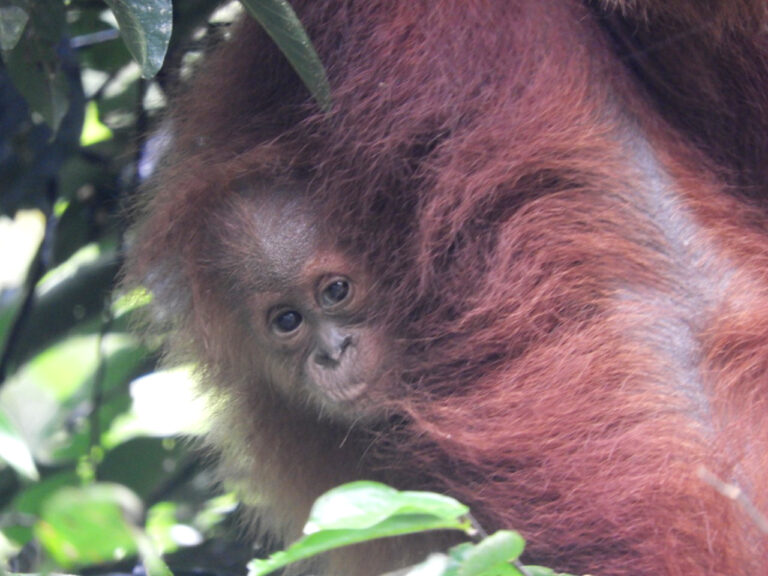«Edelweiss» – New hope for the future

«Edelweiss» – New hope for the future
A reunion with a surprise
Last February, «Edelweiss» was seen again by the Sumatran Orangutan Conservation Programme team in the forests of Jantho, for the first time since her reintroduction almost ten years ago. Our colleagues encountered a large adult female orangutan during one of their routine patrols, just a stone’s throw away from the reintroduction centre. On closer inspection she appeared to be pregnant, based on her large belly and swollen vulva, visible using binoculars. Using photos taken at the time and comparing them later to the archives everyone agreed it had to be «Edelweiss».
Welcome «Eja»
They were all surprised to see her, as she was actuallly the very first orangutan to be released from captivity in Jantho back in March 2011, and being a wild orangutan at the time she had immediately ventured deep into the forest and hadn’t been seen since. Mukhlisin, the head of the Jantho Orangutan Reintroduction Centre, remembers well, «As soon as we opened the door of her cage she headed to the nearest tree and disappeared over the hills into the depths of the rainforest.»
On August 26th «Edelweiss» showed up again for the second time this year, and this time she wasn’t alone. To the delight of all, she clearly had a young infant clinging tightly to her chest. From a safe and respectful distance, the SOCP monitoring team observed their behaviour to check that all was well. «Edelweiss» was clearly looking after her little one in the sweetest way, just as any wild orangutan mother would do.
Reward of our job
This new birth is only the third that we have witnessed and been able to confirm in Jantho among the orangutans released there to date and its always a heart-warming and incredibly rewarding thing to see for all those involved. As Dr Ian Singleton, Director of the SOCP points out «I never cease to get a huge kick out of seeing orangutans that we were able to rescue from being kept as illegal pets, often in appalling conditions, up there in the trees in Jantho behaving exactly the same as wild orangutans do elsewhere. When you remember all the hard work by the teams at the quarantine and rehabilitation centre, and then at the reintroduction centre, that goes into getting them back to the wild again too, its immensely rewarding. But to see them also carrying newly born infants, conceived and born in the wild, without ever having any contact with humans, and to know they are only there because we made that happen… well that’s just something else entirely, another level of humility and pride for all of us.»
Our goal
Since 2011 we’ve been reintroducing orangutans to the wild as part of our Sumatran Orangutan Conservation Programme. Most are confiscated illegal pets, but a few are rescued and relocated from isolated, fragmented forest patches where their chances of survival are effectively zero, due to lack of food or conflict with people. To date, 126 have been released into the Jantho Pine Forest Nature Reserve, as founders of the new wild orangutan population we are gradually establishing there. The Jantho population is actually one of two entirely new, viable wild populations that the SOCP is creating of this Critically Endangered species. Veterinarian, Dr Citrakasih Nente, who heads up all of the SOCP’s rehabilitation and reintroduction programmes explains: «These back-up populations serve as a security system for the species. They act as a kind of ‘safety net’ or ‘back up’ In case some form of catastrophe should impact the remaining truly wild populations elsewhere on Sumatra. This is extremely poignant right now of course, since the scientific consensus is that the orangutans should also be susceptible to infection by the virus and we don’t yet know how it might affect them if it does. Every orangutan released or born in the new wild populations we are creating is therefore extremely valuable and plays a critical role in the future survival of their species. Births like this one give us renewed hope that we can actually prevent the extinction of orangutans in Sumatra.»



